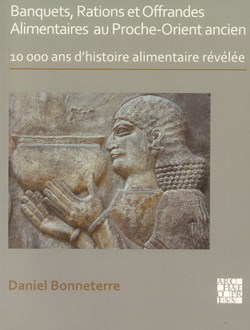Banquets, rations et offrandes alimentaires au Proche-Orient ancien : 10 000 ans d’histoire alimentaire révélée / Daniel Bonneterre.
Yer Numarası
A.IX/5434
ISBN
9781789699746
9781789699753 (e-Pdf)
9781789699753 (e-Pdf)
Dil Kodu
Fransızca
Yayın Bilgisi
Oxford, UK : Archaeopress, 2021.
Fiziksel Niteleme
xvi, 387 sayfa : resim (kimi renkli), harita (renkli) ; 24 cm
Genel Not
İndeks s. 383-387.
Bibliyografi, vb. Notu
Seçilmiş bibliyografya s. 350-382.
İçindekiler Notu
Alimentation et identité, cadre culturel -- Les lointaines origines de la table. Du sauvage au domestique -- Naissance de l'agriculture, révolution symbolique et alimentaire -- Nourrir la cité -- Le roi nourricier -- Les durs temps de la famine -- Que la fête commence! -- La diète et sa perception sur la santé -- L'alimentation végétale -- L'alimentation prodigieuse et les substances de transformation -- L'alimentation carnée -- Les boissons alimentaires -- Le détour par la cuisine.
Özet, vb.
“Banquets, Rations et Offrandes alimentaires au Proche-Orient ancien investigates the essential question of food consumption in the ancient Near East, in particular between the 4th and 1st millennium BC. Thanks to archaeological discoveries and to abundant textual documentation, historians are well equipped to reconstruct the food supply of the cities of Mesopotamia and have a better idea of the variety of products available, a far greater range than might be imagined. The analysis of the treatment of ingredients also reveals techniques unsuspected in pre-industrial times. The codification of culinary recipes developed for the use of temples also reflects a high stage of development. Religious rituals were based on a structured code of food consumption, of which prohibitions and taboos are only one facet. The book presents some aspects of everyday life in a new light. First and foremost, the banquet is seen as a critical institution in shaping urban behaviour. The representation of feasts and banquets in temples and palaces are classic themes of ancient art and literature. Understanding the importance of the meal as a rite of social cohesion, furthermore, allows us to better envision events that would unfold centuries later” -- Yayıncı.
Konu
Beslenme alışkanlıkları__Orta Doğu__Tarih.
Gıda tüketimi__Orta Doğu__Tarih.
Ziyafet__Orta Doğu__Tarih.
Beslenme alışkanlıkları__Mezopotamya__Tarih__MÖ 4.-1. Binyıllar.
Gıda tüketimi__Mezopotamya__Tarih__MÖ 4.-1. Binyıllar.
Ziyafet__Mezopotamya__Tarih__MÖ 4.-1. Binyıllar.
Yemek kültürü__Mezopotamya__Tarih__MÖ 4.-1. Binyıllar.
Gıda tüketimi__Orta Doğu__Tarih.
Ziyafet__Orta Doğu__Tarih.
Beslenme alışkanlıkları__Mezopotamya__Tarih__MÖ 4.-1. Binyıllar.
Gıda tüketimi__Mezopotamya__Tarih__MÖ 4.-1. Binyıllar.
Ziyafet__Mezopotamya__Tarih__MÖ 4.-1. Binyıllar.
Yemek kültürü__Mezopotamya__Tarih__MÖ 4.-1. Binyıllar.


